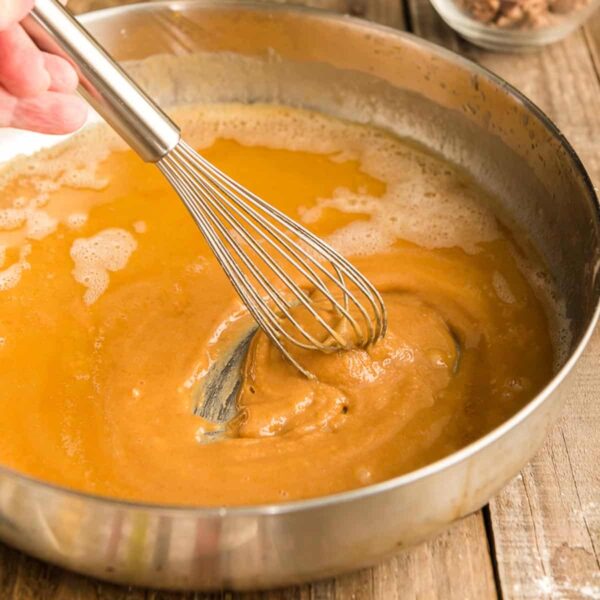How and why would you use these to thicken a soup, sauce, or stew? I still have nightmares thinking about calling 30 seconds out from a meal being delivered to the pass and knowing my sauce would never thicken to the right consistency in time. A good saucier would have a few tricks up their sleeve to make sure their head chef wouldn’t go all Gordon Ramsay on them.
Roux
While this wouldn’t save your sauce at the end of its completion, it is what you would use to thicken it beforehand. A roux, classically, is equal parts butter and flour. You would then heat the mixture so the flour is cooked through. Depending on the level of cook/darkness you achieve, it will change the roasty toastiness (remember the maillard reaction) of the final product. For example, a bechamel is light in flavor and color and begins with a white roux (little to no color). Gumbo, on the other hand, is flavored with a dark roux that has an almost chocolate color. This gives a deep and nutty flavor to the gumbo.
Side Note: Singer
Is butter the only fat you can cook your flour in? No. If you were to brown some beef and then sweat some vegetables in fat and then add some flour and allow that flour to cook in the fat, you’d be doing the same thing as a roux, except without the addition of butter. So singer is the sprinkling of flour on ingredients that have been cooked in fat.
The key to both of these thickening methods comes down to the starch granules absorbing liquid, and then swelling, thickening, and gelatinizing as they heat up. The fat helps make sure the starch grains not only keep separate, but distribute evenly and stops them from clumping. If you were to add raw flour to your liquid, it would simply clump.
Slurry
A slurry is a mixture of cornstarch and water. The same principles apply in regards to the gelatinization of starch granules thickening the sauce, but this can be added at the end of the cooking process to change the texture. This is used commonly in American Chinese food, as many of the favorites (ie General Tso’s and Orange Chicken) are thickened with a slurry to give sauces a thicker consistency. This method is generally pretty neutral in flavor, so it won’t affect the sauce too much in that regard.
Beurre Manie
This is the combination of butter and flour mixed together, except it’s not cooked at the beginning but added at the end to thicken. You would take room temperature softened butter and add flour, mixing it together to become almost a soft paste. This could be added at the end, like a slurry, but would give the finished product a more buttery flavor.
Side Note: Monter au beurre
Almost every sauce I learned at culinary school was finished with butter. To be honest, I was a little shocked at the amount of butter I was using, but then again I did go to the French Culinary Institute. My work station for service would always have about 2 pounds of butter, cubed, on ice at any given time with more butter prepped in the refrigerator. The act of Monter au beurre is the act of adding a small amount of cold butter to your sauce at the end, gently swirling it in the pan off of the heat. What this does is give the sauce some sheen, a little bit of velvety texture, and some overall smoothness to the flavor.






0 Comments